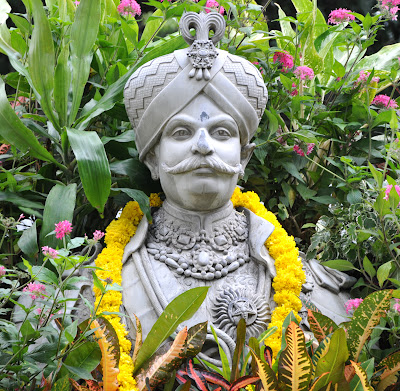 |
| Bust of Chamaraja Wadiyar at Mysore Zoo. |
During 1992, the Mysore Zoo saw a series of animal deaths causing serious concerns. Amidst these tragedies, on Oct. 10, 1992, a mithan gave birth to a male calf. The mithan had been brought from Manipur four months back. This silver lining appeared just a day before the centenary celebrations of the Zoo.
The Mysore Zoo was setup by Chamaraja Wadiyar in 1892 on a 10-acre area and was called Palace Zoo. In 1909, it was made open to public and was renamed as Sri Chamarajendra Zoological Gardens. The royal family handed over the Zoo to the then Department of Parks and Gardens after independence. It was later brought under the Forest Department in 1972 and was entrusted to the Zoo Authority of Karnataka in 1979. The Authority became the first autonomous body in the country to manage a Zoo.
Today, the Mysore Zoo is spread over an area of 78.9 acres. It houses around 164 species totalling to 1,351 specimens. It also has spacious enclosures, a veterinary hospital with quarantine, operation theatre, etc.
Much of the credit for the success of this Zoo goes to its founder Chamaraja Wadiyar (1863-1894), son of Sardar Chikka Krishnaraj Urs and Rajkumari Puta Ammani Avaru. He was the 23rd Maharaja of Mysore and ruled between 1881 and 1894.
Under his rule, Mysore saw many developmental activities like priority to women's education, industrialisation, agricultural banks and life insurance for government employees etc. He also sponsored Swami Vivekananda's journey to Chicago in 1893. Prominent landmarks like the Bangalore Palace and Lalbagh Glass House, Oriental Research Institute, Maharaja College, Maharaja's Sanskrit School, Lansdowne Building, etc. came into existence during Chamaraja Wadiyar’s time.
He was a great music patron and artistes like Veena Subbanna, Veena Seshanna, K. Vasudevacharya, Bidaram Krishnappa adorned his court. The Wadiyar also provided violin accompaniment to the above artistes.
The Chamarajendra Circle (1902) in front of Palace North gate and the Chamaraja Wadiyar statue (1908) in Lalbagh, Bangalore were erected in his memory.
To honour the King, the Zoo, as part of its centenary celebrations installed a bust of Chamaraja Wadiyar on Oct. 11, 1992, which was unveiled by scion of the royal family Srikanta Datta Narasimharaja Wadiyar. The function also saw the inauguration of the present arch gate by the then Chief Minister S. Bangarappa. Forest Minister E.T. Shambunath and Food Minister T.N. Narasimhamurthy were present. The government had sanctioned Rs. 35 lakh for the centenary celebrations.
The Wadiyar’s bust was sculpted at cost of Rs. 1.1 lakh by city’s sculptor B.S. Yogiraj Shilpi of Brahmarshi Kashyapa Shilpa Kala Shaala near Gun House. He is the fourth generation of sculptors and is the son of award winning sculptor B. Basavanna Shilpi. Presently, his sons are also accompanying him in the family tradition.
Every single detail from the designs on king’s peta to his moustache, jewellery and medal, has been meticulously sculpted. The intricate designs and embellishment on his robes are a testimony to the sculptor’s expertise.
"It took me almost three months to complete the bust made of Krishna Shile. It is one among my best works and has given a lot of satisfaction," says a proud and deserving Yogiraj.
Even though the many species in the Zoo are its star attraction, if one takes a few minutes to observe the beauty of this bust, they will realise that it is not just a work of art but a sculptor’s masterpiece.




























